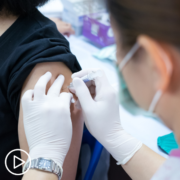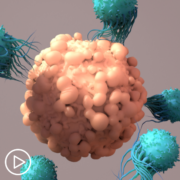How Molecular Testing Has Transformed AML Treatment Options
How Molecular Testing Has Transformed AML Treatment Options from Patient Empowerment Network on Vimeo.
How has molecular testing impacted approaches to acute myeloid leukemia (AML) therapy? Dr. David Sallman explains how molecular testing has transformed AML care, including a discussion of risk assessment and the role of next-generation sequencing (NGS) in tailoring care for each patient.
Dr. David Sallman is an Assistant Member in the Department of Malignant Hematology at Moffitt Cancer Center where he specializes in myelodysplastic syndromes (MDS), acute myeloid leukemia (AML) and myeloproliferative neoplasms (MPN). Learn more about Dr. Sallman, here.
Related Resources:

|

|

|
Transcript:
Katherine:
How has molecular testing changed the landscape of therapy for AML?
Dr. Sallman:
Yeah, it’s really transformed it, and it’s really a constantly evolving paradigm. We have updated classifications; most people utilizing the ELN system.
So, based on both cytogenetic and molecular factors, you can ultimately go into good risk, intermediate risk, adverse risk. In general, for fit patients for good risk, we focus on curative intent, ideally with chemotherapy alone. For intermediate and adverse, typically we’re incorporating allogeneic stem cell transplant. So, that’s one of the main things that really guides treatment really from the beginning and throughout.
Then, I think really where it’s evolving is personalized therapy. So, it’s really not a one-size-fits-all treatment paradigm, it’s you have mutation A, B, you’re this age, this fitness, and we put all those things together to ideally come up with the best treatment plan for the patient.
Katherine:
Is molecular testing standard following an AML diagnosis or is this something that patients should ask for?
Dr. Sallman:
It definitely should be standard and I think the challenge is when you say the word “molecular,” it means lots of things to different people. I think in the community, as targeted medications were first approved, so this was with FLT3 inhibitors, subsequently IDH1 and IDH2 inhibitors, I think people are realizing yes, we have to send these sequencing panels, but there’s a potpourri of choices from a lot of different commercial vendors.
Really the key and one of the main messages we try to get across is you really have to assess for both FLT3 as well as really a comprehensive next-gen sequencing panel in order to cover all of the relevant genes at diagnosis and likely at other time points such as relapsed or refractory disease.
So, there’s no question, it’s standard, although unfortunately, it’s still not uncommon where the comprehensive panels are not sent and you’re left with somewhat not a complete picture for your patients. Since we’re personalizing everything, it’s really quite critical to have these data.
Katherine:
Yeah. How does inhibitor therapy work to treat AML?
Dr. Sallman:
So, you have a gene that turns on and turns off as we go, but with the mutation, it’s basically turned on all the time. Then, you can have targeted pills that basically turn it off. Most commonly this is done, there’s the active
or energy site for these different genes, and so these therapies can really specifically block that. I wouldn’t say that’s the only mechanism. There are IDH1 and IDH2 inhibitors and they’re very specific for those mutations. Each mutation may have a little bit different end biology. In general, you have mutation A, and we’re going to turn it off with drug that inhibits A.










